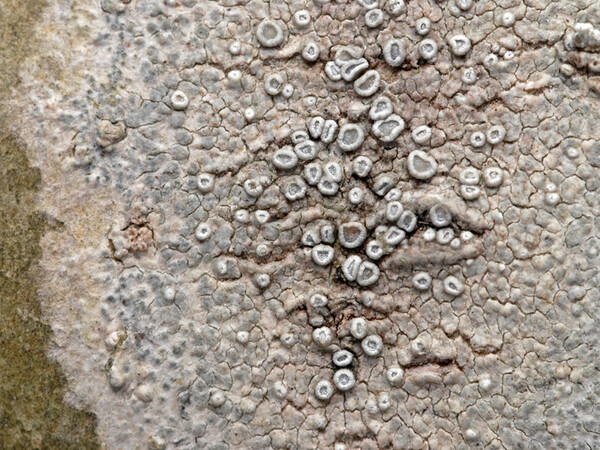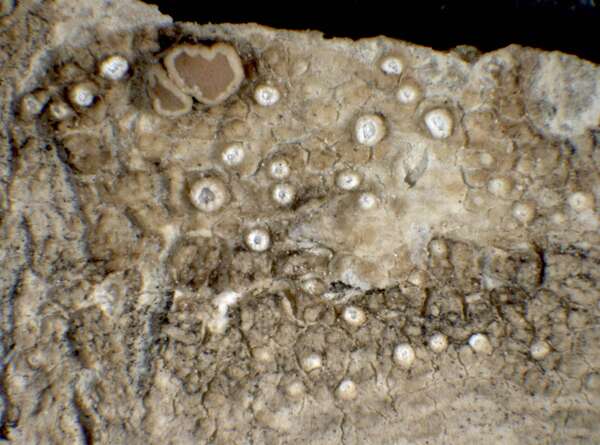Polyozosia populicola (DC.) S.Y. Kondr., Lőkös & Farkas
in Kondratyuk & al., Acta Bot. Hung., 61, 1-2: 156, 2019. Basionym: Patellaria populicola DC. in Lamarck & de Candolle - Fl. Franç., éd. 3, 2: 363, 1805.
Synonyms: Lecanora distans (Pers.) Nyl.; Lecanora populicola (DC.) Duby; Lecanora subfusca var. distans (Pers.) D. Dietr.; Myriolecis populicola (DC.) P.F. Cannon
Distribution: N - Ven, TAA (Nascimbene & al. 2007b), Lomb, Piem (Piervittori 2003, Isocrono & al. 2004, 2007), VA (Ongaro & al. 2022), Emil (Fariselli & al. 2020), Lig (Giordani & al. 2025). C - Tosc, Sar. S - Camp (Aprile & al. 2003b), Bas, Cal (Puntillo 1996), Si (Grillo 1998, Grillo & Caniglia 2004).
Description: Thallus crustose, episubstratic, whitish to pale grey, continuous to rimose-areolate in central parts, often delimited by a concentrically zoned, fimbriate, pale grey prothallus, forming clearly delimited, orbicular or elliptical patches. Apothecia lecanorine, concentrated in the central parts of thallus, up to 1.5 mm across, at first immersed, later sessile and more or less constricted at base, with a pale brown to pinkish brown, usually white- or grey-pruinose (at least when young), flat disc and a prominent, white pruinose, smooth to crenulate thalline margin. Thalline exciple rich in crystals, the medulla with abundant algae; epithecium colourless to pale brown, with small crystals; hymenium colourless, 45-80 µm high; paraphyses sparingly branched, 1-2 µm thick, hardly swollen at apices; hypothecium colourless, with small granules. Asci 8-spored, elongate-clavate, very thin-walled, with a K/I+ blue, tall tholus penetrated by a faintly amyloid apical cushion, the wall K/I-, surrounded by a K/I+ blue outer layer, Lecanora-type. Ascospores 1-celled, hyaline, ellipsoid, 10-16 x 6-9 µm. Photobiont chlorococcoid. Spot tests: thallus and apothecia K-, C-, KC-, P-, UV-. Chemistry: traces of 2.5-dichlorolichexanthone. Note: a cool-temperate to circumboreal-montane lichen found especially on Populus tremula and Alnus in the montane belt. Several Italian records need reconfirmation. It is included in the Italian red list of epiphytic lichens as “Data Deficient” (Nascimbene & al. 2013c).
Growth form: Crustose
Substrata: bark
Photobiont: green algae other than Trentepohlia
Reproductive strategy: mainly sexual
Commonnes-rarity: (info)
Alpine belt: absent
Subalpine belt: absent
Oromediterranean belt: absent
Montane belt: very rare
Submediterranean belt: absent
Padanian area: absent
Humid submediterranean belt: absent
Humid mediterranean belt: absent
Dry mediterranean belt: absent

Predictive model
Herbarium samples
Growth form: Crustose
Substrata: bark
Photobiont: green algae other than Trentepohlia
Reproductive strategy: mainly sexual
Commonnes-rarity: (info)
Alpine belt: absent
Subalpine belt: absent
Oromediterranean belt: absent
Montane belt: very rare
Submediterranean belt: absent
Padanian area: absent
Humid submediterranean belt: absent
Humid mediterranean belt: absent
Dry mediterranean belt: absent

Predictive model
| Herbarium samples |
 DOLICHENS
DOLICHENS




